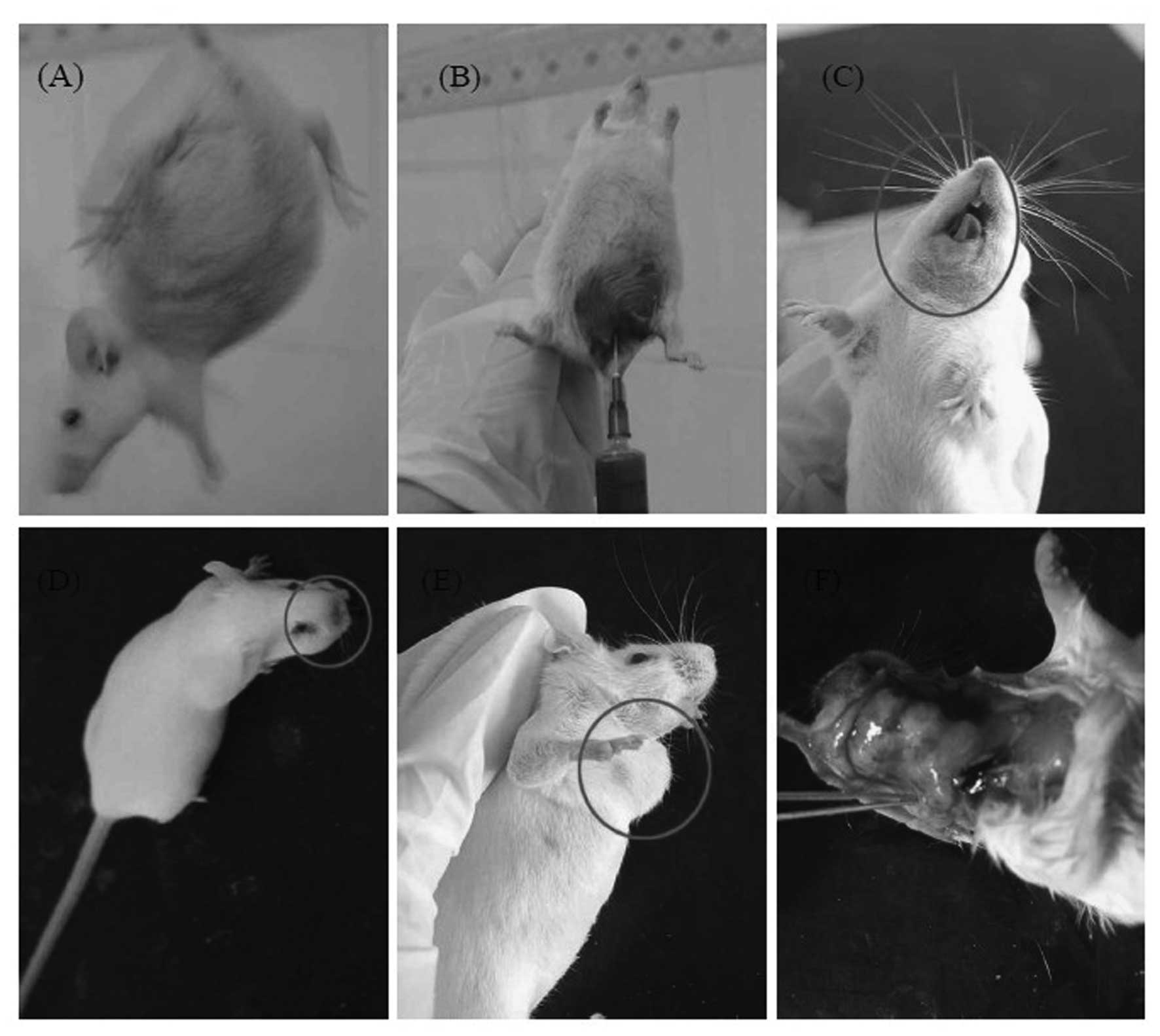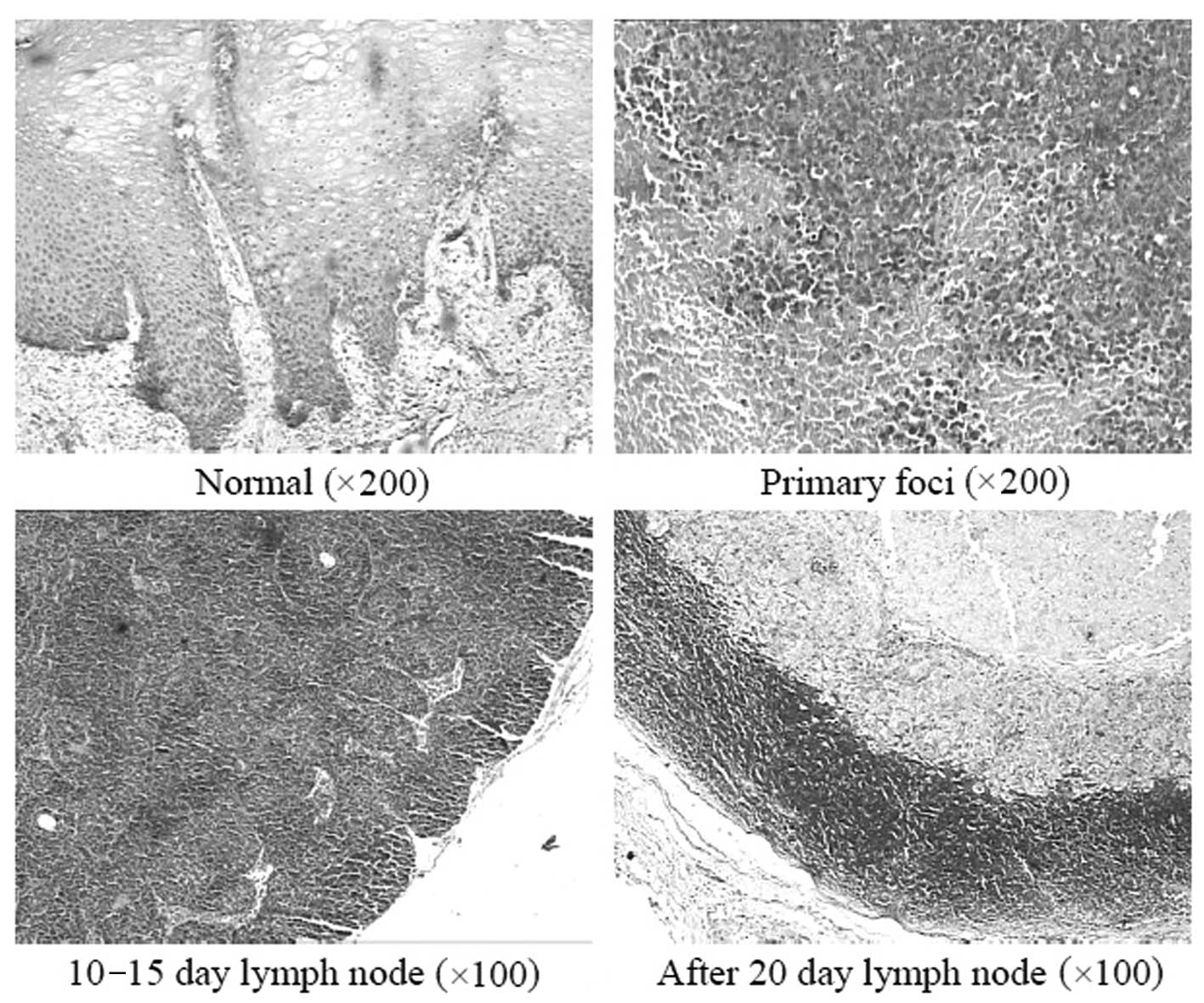|
1
|
Chaturvedi AK, Engels EA, Anderson WF and
Gillison ML: Incidence trends for human papillomavirus-related and
-unrelated oral squamous cell carcinomas in the United States. J
Clin Oncol. 26:612–619. 2008. View Article : Google Scholar : PubMed/NCBI
|
|
2
|
Hong WK, Lippman SM, Itri LM, Karp DD, Lee
JS, Byers RM, Schantz SP, Kramer AM, Lotan R, Peters LJ, Dimery IW,
Brown BW and Goepfert H: Prevention of second primary tumors with
isotretinoin in squamous-cell carcinoma of the head and neck. New
Engl J Med. 323:795–801. 1990. View Article : Google Scholar : PubMed/NCBI
|
|
3
|
Alam M and Ratner D: Cutaneous
squamous-cell carcinoma. New Engl J Med. 344:975–983. 2001.
View Article : Google Scholar : PubMed/NCBI
|
|
4
|
Duvoux C, Delacroix I, Richardet JP,
Roudot-Thoraval F, et al: Increased incidence of oropharyngeal
squamous cell carcinomas after liver transplantation for alcoholic
cirrhosis. Transplantation. 67:418–421. 1999. View Article : Google Scholar : PubMed/NCBI
|
|
5
|
Mognetti B, Carlo FD and Berta GN: Animal
models in oral cancer research. Oral Oncol. 42:448–460. 2006.
View Article : Google Scholar : PubMed/NCBI
|
|
6
|
Gu B, Feng HL, Dong JH, Zhang H, Bian XC
and Liu YQ: The establishment and characterization of a continuous
cell line of mouse cervical carcinoma. Chin J Clin Oncol. 5:44–48.
2008. View Article : Google Scholar
|
|
7
|
Liu XF, Ren LR, Su GY, Liu YQ, Gu B and
Dong JH: Establishment and characterization of a rabbit tumor cell
line VX2. Chinese J Pathol. 34:661–663. 2005.(In Chinese).
|
|
8
|
Su GY, Liu XF, Ren LR, Gu P, Zhang JB and
Liu YQ: Establishment and characterization of a continuous cell
line of mouse breast cancer. Chinese J Clin Oncol. 33:1150–1152.
2006.
|
|
9
|
Rattanasinganchan P, Leelawat K,
Treepongkaruna SA, Tocharoentanaphol C, Subwongcharoen S,
Suthiphongchai T and Tohtong R: Establishment and characterization
of a cholangio-carcinoma cell line (RMCCA-1) from a Thai patient.
World J Gastroenterol. 12:6500–6506. 2006.PubMed/NCBI
|
|
10
|
Schrader M and Laberke HG: Differential
diagnosis of verrucous carcinoma in the oral cavity and larynx. J
Laryngol Otol. 102:700–703. 1988. View Article : Google Scholar : PubMed/NCBI
|
|
11
|
Bak SS, Kong CS, Rhee SH, Rho CW, Kim NK,
Choi KL and Park KY: Effect of sulfur enriched young radish kimchi
on the induction of apoptosis in AGS human gastric adenocarcinoma
cells. J Food Sci Nutr. 12:79–83. 2007. View Article : Google Scholar
|
|
12
|
Kim YA, Rhee SH, Park KY and Choi YH:
Antiproliferative effect of resveratrol in human prostate carcinoma
cells. J Med Food. 6:273–280. 2003. View Article : Google Scholar : PubMed/NCBI
|
|
13
|
Gao J and Zhang JB: Tumor Invasion and
Metastasis. Science Publishing House; Beijing: pp. 531–532.
2003
|
|
14
|
Xuan M, Weng YM, Wang CM and Li XQ:
Pathologic changes of lymphatic capillaries after inoculation of
U14 cells in rat tongue perineoplastic area. West China J Stomatol.
18:5–8. 2000.PubMed/NCBI
|
|
15
|
Milanezi F, Leitão D, Ricardo S, Augusto I
and Schmitt F: Evaluation of HER2 in breast cancer: reality and
expectations. Expert Opin Med Diagn. 3:607–620. 2009. View Article : Google Scholar : PubMed/NCBI
|
|
16
|
Chao DT and Korsmeyer SJ: Bcl-2 family:
regulators of cell death. Annu Rev Immunol. 16:395–419. 1998.
View Article : Google Scholar
|
|
17
|
Blanc C, Deveraux QL, Krajewski S, Jänicke
RU, Porter AG, Reed JC, Jaggi R and Marti A: Caspase-3 is essential
for procaspase-9 processing and cisplatin-induced apoptosis of
MCF-7 breast cancer cells. Cancer Res. 60:4386–4390.
2000.PubMed/NCBI
|
|
18
|
Kirsch DG, Doseff A, Chau BN, Lim DS, de
Souza-Pinto NC, Hansford R, Kastan MB, Lazebnik YA and Hardwick JM:
Caspase-3-dependent cleavage of Bcl-2 promotes release of
cytochrome c. J Biol Chem. 274:21155–21161. 1999. View Article : Google Scholar : PubMed/NCBI
|
|
19
|
Delić R and Štefanović M: Optimal
laboratory panel for predicting preeclampsia. J Maternal-Fetal
Neonatal Med. 23:96–102. 2010.PubMed/NCBI
|
|
20
|
Baeuerle PA: IkappaB-NF-kappaB structures:
at the interface of inflammation control. Cell. 95:729–731. 1998.
View Article : Google Scholar : PubMed/NCBI
|
|
21
|
Klein CA: Cancer. The metastasis cascade
Science. 321:1785–1787. 2008.PubMed/NCBI
|
|
22
|
Vihinen P, Ala-Aho R and Kahari VM: Matrix
metalloproteinase as therapeurtic targets in cancer. Curr Cancer
Drug Targets. 5:203–220. 2005. View Article : Google Scholar : PubMed/NCBI
|
|
23
|
Davies B, Waxman J, Wasan H, Abel P,
Williams G, Krausz T, Neal D, Thomas D, Hanby A and Balkwill F:
Levels of matrix metalloproteinase in bladder cancer correlate with
tumor grade and invasion. Cancer Res. 53:5365–5369. 1993.PubMed/NCBI
|
|
24
|
Chen PN, Chu SC, Chiou HL, Kuo WH, Chiang
CL and Hsieh YS: Mulberry anthocyanins, cyanidin 3-rutinoside and
cyanidin 3-glucoside, exhibited an inhibitory effect on the
migration and invasion of a human lung cancer cell line. Cancer
Lett. 235:248–259. 2006. View Article : Google Scholar : PubMed/NCBI
|
|
25
|
Uzui H, Harpf A, Liu M, Dogerry TM, Shukla
A and Chai N: Increased expression of membrane type 3-matrix
metalloproteinase in human atherosclerotic plaque: role of
activated macrophage and inflammatory cytokines. Circulation.
106:3024–3030. 2002. View Article : Google Scholar : PubMed/NCBI
|
|
26
|
Lambert E, Dasse E, Haye B and Petitfrere
E: TIMPs as multi-facial proteins. Crit Rev Oncol Hematol.
49:187–198. 2004. View Article : Google Scholar : PubMed/NCBI
|
|
27
|
Deryugina EI and Quigley JP: Matrix
metalloproteinases and tumor metastasis. Cancer Metastasis Rev.
25:9–34. 2006. View Article : Google Scholar
|
|
28
|
Krüger A, Fata JE and Khokha R: Altered
tumor growth and metastasis of a T-cell lymphoma in TIMP-1
transgenic mice. Blood. 90:1993–2000. 1997.PubMed/NCBI
|
|
29
|
Krüger A, Sanchez-Sweatman OH, Martin DC,
Fata JE, Ho AT, Orr FW, Rüther U and Khokha R: Host TIMP-1
overexpression confers resistance to experimental brain metastasis
of a fibrosarcoma cell line. Oncogene. 16:2419–2423.
1998.PubMed/NCBI
|
|
30
|
Liu S, Zhao F and Ben C: Evaluation of
clinical and pathological factors relating to lymph node metastasis
in carcinoma of the tongue. Zhonghua Kou Qiang Yi Xue Za Zhi.
31:259–262. 1996.(In Chinese).
|

















